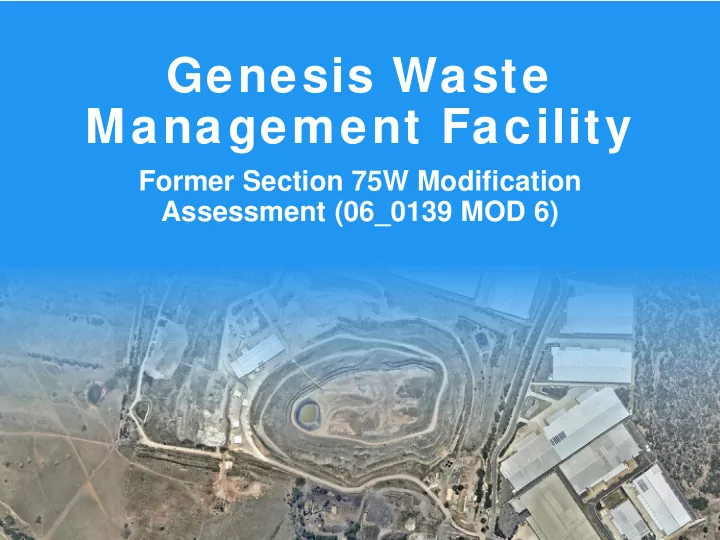

Genesis Waste Management Facility Former Section 75W Modification Assessment (06_0139 MOD 6)
Regional Context
Development Background • Existing waste management facility (WMF) approved in November 2009 • Previously operated by Dial-A-Dump, now acquired by Bingo • WMF has two main components: resource recovery and a non-putrescible landfill • Landfill component uses quarry void (1950s-2005) • Currently accepts 2,000,000 tonnes per annum (tpa) of solid (non-putrescible) and asbestos waste – of this only 700,000 tpa can be landfilled
Western Sydney Employment Area (WSEA) • Area has been zoned for industrial use as part of the WSEA since 2009 • Progressive development has provided a range of employment generating (e.g. warehousing, freight, distribution centres) • Identifies 2,100 ha of employment land (NSW’s largest employment land) • WSEA extension preserves additional 4,250 ha
Site WSEA Extension (unzoned) WSEA Land Zoning Map
Modification Request • 1,000,000 tpa direct-to-landfill, not including residual waste from MPC • Increase the hours of operation of certain activities (enclosed processing works, landfilling and ancillary works) • Revised noise limits to reflect the contemporary noise environment
Proponent’s Justification • Projected market growth for resource recovery and landfill disposal due to large-scale infrastructure projects and major development in Western Sydney • Residual waste from other Bingo facilities • Increase in contaminated material, such as asbestos and soil contaminated with heavy metals • Queensland waste levy
Site Layout
Developments in the Site Vicinity
Waste Hierarchy • Residual waste from other resource recovery facilities operated by the Proponent • Disposal for problem wastes, such as asbestos contaminated waste and bushfire waste • Shorten landfill lifespan by up to 7 years • Resource recovery arm of the operation • Utilising and rehabilitating a former quarry site
Exhibition • Modification request exhibited between 3 October 2018 until 17 October 2018 • 70 submissions received, including 62 objections • Blacktown City Council objected
Summary of issues raised in community submissions
Response to Submissions • First iteration provided in May 2019 • DPIE and EPA requested additional information on several occasions • Adjacent business owner provided numerous submissions that included advice from experts engaged to peer review the Proponent’s assessments • Final consolidated RTS provided in November 2019
Air Quality • Proponent prepared an air quality impact assessment (AQIA) which identified dust as the key pollutant • Dust is measured in total suspended particulate matter (TSP), PM 10 and PM 2.5 • AQIA concluded the modification would result in minor increases in PM, with the PM 2.5 criteria being exceeded • Proponent argues approach is conservative as it assumes a lower resource recovery rate than currently experienced Note: µg/m 3 = micrograms per cubic metre
Average peak day 24-hour and annual PM 2.5 modelling predictions for the modification PM 2.5 PM 2.5 PM 2.5 PM 2.5 Receptor Receptor Type Mod Increment Cumulative Mod Increment Cumulative 24 hour (25µg/m 3 ) Annual (8µg/m 3 ) Criterion R01 2.1 24.8 0.4 9.0 R02 2.4 24.8 0.5 9.1 R03 2.6 25.1 0.5 9.1 R04 2.8 25.3 0.6 9.2 R05 3.0 25.4 0.6 9.2 R06 Residential 2.6 25.2 0.5 9.1 R07 2.9 25.3 0.6 9.2 R08 2.9 25.3 0.6 9.2 R09 0.5 24.4 0.1 8.7 R10 0.6 24.4 0.1 8.7 R11 0.7 24.4 0.1 8.7 R12 4.8 26.5 1.2 9.8 R13 4.1 26.9 1.1 9.7 R14 Commercial/ 2.7 26.2 0.7 9.3 R15 industrial 3.3 26.4 0.9 9.5 R16 4.2 26.8 1.1 9.7 R17 3.8 25.5 0.7 9.3
Mod Increment 24 Hour Average PM 2.5 Concentration (µg/m 3 )
Mod Increment Annual Average PM 2.5 Concentration (µg/m 3 )
Air Quality • Background PM 2.5 concentrations ranged from 8.7- 9.7 µg/m 3 , which already exceeds the criteria of 8 µg/m 3 • AQIA attributed high levels of background PM to vehicle emissions, bushfire, hazard reduction and dust storms • Use of haul roads identified as largest dust generator from the site
Recommended Conditions • Review and update the Chute Management and Maintenance Plan • Update the Air Quality Management Plan to include real-time boundary monitoring and trigger levels for remedial action • Within 6 months, submit a site-wide air quality audit conducted by an independent expert and prepared in consultation with the EPA
Noise • Proponent prepared a noise impact assessment (NIA) which demonstrated ambient noise levels currently exceed the noise limits set in the Project Approval • Modification aims to align noise limits consistent with current noise policies for managing the amenity of noise catchments surrounding developing industrial estates (such as the WSEA)
Rapid development within the WSEA over the past ten years, combined with the nearby M4 and M7 Motorways, have altered the surrounding noise environment
Noise • Proponent conducted additional noise monitoring at the request of DPIE and EPA to confirm estimates in the NIA • EPA recommended noise limits based on the Proponent’s predicted noise levels • Revised noise limits will more accurately reflect the contemporary noise environment and the project’s impact on nearby receivers • Project predicted to meet INP derived noise objectives
Recommended Conditions • Revised noise limits • Post-commissioning report to validate the noise predictions of the NIA • Review and update the existing Environmental Management Strategy and Noise Monitoring Program
Other Assessment Matters Traffic • Council and several public submissions raised increased traffic as a concern • Proponent’s traffic impact assessment estimated an additional 492 truck movements, for a daily total of 1,284 movements, however these additional movements would occur during the evening and night time periods • WSEA has been developed to accommodate large volumes of traffic
Other Assessment Matters Odour • Putrescible waste is not processed or landfilled • Modification does not introduce new waste streams or operational activities on the site Leachate • Capacity of existing leachate treatment system is 325,850 m 3 per annum • Maximum discharge permitted under Trade Waste Agreement is 237,250 m 3 per annum • Estimated maximum volume of leachate that would be generated at completion of landfilling is 185,000 m 3 per annum
Recommend
More recommend